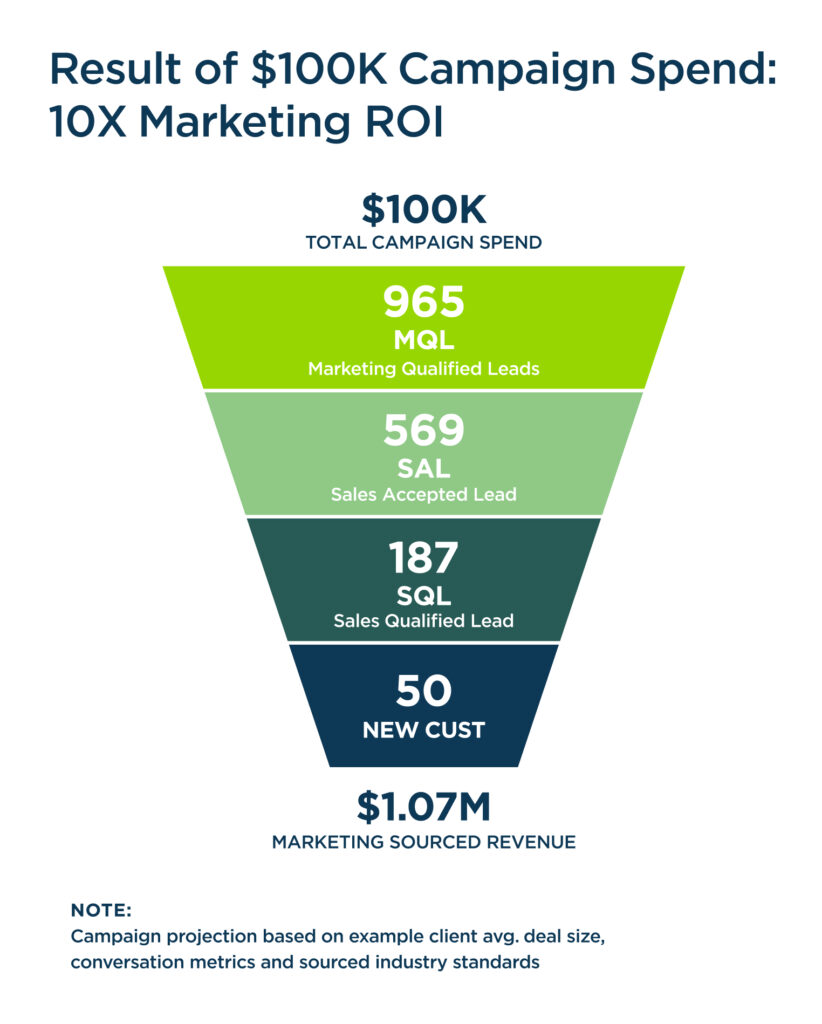How do you supercharge your sales organization to deliver accelerated growth? The answer is through revenue-driven marketing. Some of the most successful private equity operating partners are focusing their portcos on marketing as the key to sustainable growth. By investing in revenue marketing, you will drive continued EBITDA growth across your portcos. The path to transforming a marcom-focused marketing team into a revenue-driving machine can be summed up in three steps.
- Know your buyers: Use market segmentation to determine who your most profitable customers are and how to reach them efficiently
- Many clients I’ve worked with have used a shotgun blast approach to marketing campaigns because they don’t know their buyers. It’s always a shock to them when I say, “I’m going to reduce the number of prospects you reach while increasing your lead volume.” This is possible because we can target the prospects most likely to engage once we know who the most profitable audiences are, how to reach them, and how to speak to them.
- Build a revenue-based marketing budget: Use segmentation to forecast the pipeline and budget you need for each Go-to-Market segment and sales territory
- There’s a great example of a revenue-based budget later in this post. The budget example was the first-ever marketing budget of any kind for the client. It also highlights that it doesn’t need to be complicated to start. Keep it simple, focused, and measurable, and you’ll be off to a great start!
- Measure and hold accountable: Give the CMO a revenue goal that is tied to compensation
- As someone who’s been a client-side CMO, I have always asked to have revenue goals. This has allowed me to justify marketing headcount by tying it back to revenue, and at one company, it highlighted (all the way up to the board level) that marketing was responsible for 33% of all new customer acquisition. With that kind of revenue-generating story, marketing should be an area of increased investment!
Know Your Buyers to Begin EBITDA Growth
Knowing your buyers requires investment in analytics that can be replicated across all portfolio companies. Market segmentation is the foundation for every revenue-generating marketing organization. In addition to refining your targeting, it allows revenue driven marketing to become far more effective, as it allows you to do three key things:
- Focus on customers that matter most: Break the market into groups of customers you can target rather than addressing the market as a whole. (More is not better, better is better)
- Deploy more effective lead generation: Gain valuable input into marketing strategies. Indicates who to target and can reveal where to find these people and how to speak to them, leading to better-qualified leads.
- Improve resource allocation: Become more efficient with the deployment of marketing resources (media dollars, content development dollars, human time allocation, etc.).
Market Segmentation
So how is market segmentation executed? There are four key areas of market segmentation.
- Market analysis: Divide all prospects and current referents into groups and assign a numeric value based on current and future potential. Also known as Total Addressable Market (TAM) and Ideal Customer Profile (ICP) development.
- Buyer Personas: Build target prospects grouped by their behaviors in terms of how they buy, challenges they have, and objections to buying.
- Buying Process Maps: Develop a visual representation that depicts your target customers’ possible thoughts, emotions, and actions throughout the purchase process.
- Customer Insights and analytics: Create an ongoing means for collecting trends in customer behavior, sales data, and direct feedback to stay in tune with the customer. Social media, customer satisfaction surveys, and buyer panels are great examples of how to get direct feedback.
Taking the four steps mentioned above will lay the foundation for building high-growth marketing functions.
Build a Revenue Driven Marketing Budget
Now that the foundation has been laid with market segmentation, you are ready to build a revenue-driven marketing budget. Use the segmentation discussed in the first section to forecast the pipeline and budget needed from marketing to achieve sales goals. The budget should also always be aligned to sales goals. The example below illustrates how Cortado Group used account segmentation to build a revenue-based marketing budget for a client.
The following steps were taken for our client to build the marketing budget.
- Assess current marketing budget: Cut line items that are not supporting revenue growth.
- Determine industry benchmarks for marketing spend: HubSpot estimates that B2B companies spend between 5.9% and 6.5% of revenue on marketing.
- Use account segmentation: Use the ICP mentioned earlier in this piece to determine marketing reach. In this example, the ICP contained 70K potential prospects.
- Leverage sales/marketing funnel conversion rates: Based on conversion rates, project how many leads are needed at each stage of the funnel to deliver the desired number of new customers.
- Use digital marketing benchmarks: Leverage digital reach estimates to determine how much budget is needed to reach the desired number of prospects (70K in our example).
- Ensure sales and marketing are aligned: Develop a sales and marketing service level agreement (SLA) and schedule regular meetings so that both can hold each other accountable.
For the client in this example, we input the needed data points from above and used our proprietary revenue model to project incremental marketing revenue of over $1M.
Measure and Hold Accountable
Lastly and probably most important, give the CMO a marketing revenue attribution goal tied to compensation. Your A-player CMOs will love this and perform at peak levels. Most CMO’s are not given revenue goals to hit, and this is a common mistake. By giving the CMO revenue goals, it ensures that the bulk of the marketing budget is spent on lead generation, keeping the marketing team accountable in addition to driving EBITDA growth. The goals should be documented, tracked monthly, and adjusted mid-year based on results.
By following the proven steps laid out in this post, Cortado has helped many portcos accelerate lead generation that drives top-line sales. Our proprietary tools and unique approach to marketing accountability can be replicated across the PE portfolio to help meet or exceed ongoing EBITDA goals. To get you started on the path to revenue marketing, I included a link to download our Marketing ROI Calculator.









